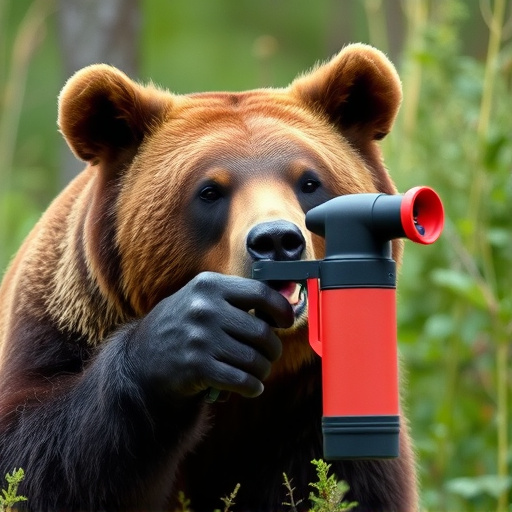The capsaicin concentration in bear repellent determines its effectiveness against bears. Higher concentrations (2%-10%) provide greater protection. For casual encounters, lower concentrations (0.5%-2%) suffice, while remote areas may require up to 15%. Master application technique, choose approved products, and remember no repellent guarantees 100% safety. Aim directly at bear's face from 20-30 feet, using 2%+ capsaicin for optimal protection.
In the face of potential predator encounters, understanding bear spray defense is vital. This article guides you through the essentials of bear spray as a powerful tool for self-protection in wild environments. We explore the science behind capsaicin concentration in bear repellents, offering insights into what makes them effective. Learn how to choose the right product and master application techniques for optimal safety when venturing into bear country.
- Understanding Bear Spray: How It Works
- Deciphering Capsaicin Concentrations: The Key to Effectiveness
- Choosing the Right Bear Repellent for Your Needs
- Application Techniques for Optimal Protection
Understanding Bear Spray: How It Works
Bear spray, also known as bear repellent, is a potent defense mechanism designed to deter predatory bears when faced with an encounter in their natural habitat. It functions by utilizing capsaicin, the active ingredient found in chili peppers, which irritates the mucous membranes of the target animal. The capsaicin concentration in bear repellent plays a crucial role in its effectiveness; higher concentrations ensure a quicker and more reliable response from the bear.
When sprayed towards a bear, the capsaicin creates an unpleasant sensory experience, temporarily blinding and disorienting it. This disruption allows the human to create distance and escape potential harm. The spray’s formula is carefully balanced to be powerful enough to deter bears but safe for humans, with minimal risk of serious injury. Understanding how bear spray works and carrying it responsibly can significantly increase survival chances during encounters in bear country.
Deciphering Capsaicin Concentrations: The Key to Effectiveness
Deciphering capsicum concentrations is essential when considering bear spray as a defense against predators. The effectiveness of any bear repellent largely depends on the capsaicin concentration, a key active ingredient derived from chili peppers. A higher capsaicin concentration means greater irritancy and potential deterrence for bears.
Manufacturers typically measure this concentration in parts per million (ppm). Bear sprays with concentrations ranging from 2% to 10% are commonly available. Higher concentrations offer more protection, but proper application technique is crucial. Using a spray with an appropriate capsaicin level ensures that you have a reliable defense while also considering the environmental impact and potential for user safety.
Choosing the Right Bear Repellent for Your Needs
Choosing the right bear repellent is crucial, depending on your specific needs and environment. One key factor to consider is the capsaicin concentration—the active ingredient in most bear sprays. For casual hikers or campers, a lower concentration (around 0.5% – 2%) might suffice for deterring curious bears at close range. Higher concentrations (up to 15%) are recommended for more remote or dangerous areas, where encounters with aggressive bears are possible.
When selecting a bear repellent, look for products approved by relevant authorities and backed by research. Always check the usage instructions and safety guidelines, as proper application is essential for effectiveness. Remember that no single repellent can guarantee 100% protection, but combining it with noise makers, food storage practices, and awareness of your surroundings can significantly reduce bear-human conflicts.
Application Techniques for Optimal Protection
Effective application techniques are crucial for maximizing the protection offered by bear spray. For optimal results, users should aim directly at the predator’s face and eyes from a safe distance, typically around 20-30 feet (6-9 meters). This ensures that the capsaicin concentrate comes into direct contact with the animal’s sensitive mucous membranes, triggering a temporary yet powerful response.
Many bear repellent products claim varying capsaicin concentrations, but understanding how this chemical works is essential. Capsaicin, the active ingredient in chili peppers, creates a burning sensation by disrupting nerve signals. A higher concentration means more potent protection, typically measured in parts per million (ppm). Products with 2% or more capsaicin are generally considered effective for bear deterrence, but always check the label for specific details on application and safety instructions.
Bear spray is a powerful tool for self-defense against predators, with capsaicin concentration playing a pivotal role in its effectiveness. Understanding how bear spray works and choosing the right product tailored to your needs can significantly enhance safety while hiking or camping in bear country. Proper application techniques ensure optimal protection, making it an indispensable companion for outdoor enthusiasts navigating potentially dangerous environments. Remember, knowledge is the best defense, so be prepared and stay safe.
